Comfortable living conditions are the key to happiness. How to create an ideal heating system in an apartment?
You are viewing the section In the apartment, located in the large section Heating.
Subsections: Counters.

Due to the limited space of the apartment and taking into account certain fire safety requirements, some of the existing types of heating systems cannot be used in such residential premises.
The optimal option remains either central heating or an autonomous system running on electricity/gas.
Types of heating in the apartment
It is used for heating apartment premises. several types heating systems.
Autonomous system
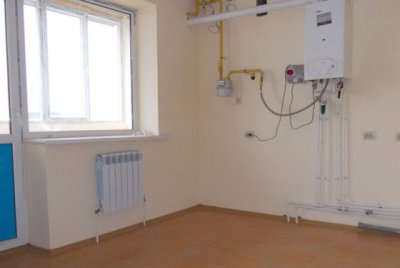
As practice shows, central heating is slowly beginning to outlive its usefulness.
In this regard, manufacturers of heating equipment began to launch on the consumer market a large number of products intended for heating residential premises.
Before making a choice in favor of such a heat carrier, It is necessary to take into account all the features of the living space: the location of the apartment, the presence of heat leaks (old windows, cracks in doors, cracks in walls, etc.).
An autonomous heating system, of course, has its advantages, which encourages many homeowners (especially in new buildings) to install it in their homes:
- Possibility of creation excellent microclimate in the house;
- The system can only be turned on when when needed;
- Possibility of regulating temperature level not only throughout the apartment, but also in each room separately;
- Moderate level of expenses, since payment is made strictly according to the meter.
As an individual type of heating in multi-storey buildings it is used There are mainly two types of autonomous systems: gas (gas water heater) and electric (electric boiler).
Gas-powered heating devices are particularly popular among consumers. These are quite affordable units with a closed combustion chamber that can be used not only for heating water, but also as a source of heating for housing.
This type of heating equipment is relevant due to some positive features:
- Comfortable temperature level regardless of gas pressure;
- Possibility of using a gas water heater even in small apartments;
- Silence of the device;
- Multiple levels of protection to maximize system security;
- Automated work process.
Gas heating as such, has no obvious disadvantages. One can only note the fierce resistance of public utilities against the installation of such structures due to the possibility of disrupting the hydraulic balance.
Heating of premises with the help of an electric boiler is considered the main source of heat. The principle of operation of an electric boiler is almost identical to the operation of a wall-mounted gas boiler. The only difference is in the method of heating the coolant: This happens during the operation of the heating element, which converts electricity into heat.

Photo 1. Gas boiler in a system with a boiler. Used for heating and water heating.
Heating with an electric boiler is considered very advantageous from many points of view:
- Economy;
- High-quality heating of premises;
- Complete autonomy;
- High level of protection of all elements of the electric boiler.
But, unfortunately, electric heating boilers also have disadvantages:
- Limited resource of the heating element;
- Special requirements for water hardness: a large amount of scale can form very quickly on the surface of the heating element, which will put it out of order.
Important! When buying an electric heating boiler, you need to pay attention to one thing: is there a possibility of replacement? heating element. This necessity is connected with the fact that it is often precisely he fails first.
Central heating in apartment buildings
Despite the rapid expansion of the market for devices for autonomous heating in residential buildings, Central heating is still very much in demand, and not only in the domestic space, but also beyond its borders. This is connected, first of all, with the reliability and quality of work of both the entire system as a whole and its individual elements.

When creating a central heating unit, the main heat source most often used is either boiler houses or thermal power plants.
It is worth noting that the latter are more efficient (one thermal power plant can replace several boiler houses), since their operation is based on the use of waste steam entering the home's heating system to heat the water in the pipes.
The degree of water supply to the heating system is regulated at the heating station. using circulation pumps. This scheme of supplying the heat carrier to the housing is called independent. The dependent heating scheme implies the transportation of the heat carrier directly to the apartment pipes without redistribution directly from the thermal power plant.
The central heating system has a number of undeniable advantages:
- Use of inexpensive types of fuel;
- Reliability due to the possibility of regular monitoring of its technical condition and functionality;
- Ease of operation of all elements;
- Possibility of using environmentally friendly equipment.
The central heating system also has disadvantages:
- Frequent and sometimes strong pressure changes;
- Strictly time-limited functionality (exclusively during the cold season);
- Impossibility of individual adjustment of heating elements;
- Significant heat losses during transportation to apartment buildings.
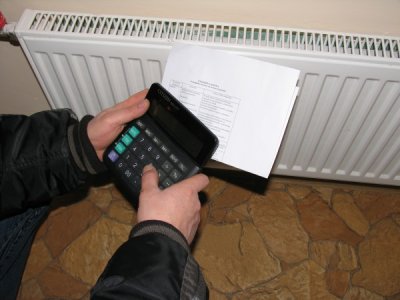
There are a number of standard indicators, according to which heating of residential premises in apartment buildings is ensured during the cold season:
- Living room - 18-24 degrees;
- Toilet - 18-26 degrees;
- Kitchen - 18-26 degrees;
- Bathroom/combined toilet — 18-26 degrees;
- Lobby - 14-20 degrees;
- Storerooms - 12-22 degrees.
Permissible deviations from the norm: 4 degrees above normal And 3 lower respectively.
Attention! The maximum period of time during which housing may not be heated in winter is 1 day in 30 days, and no more than 16 hours at a time. If the specified time limit is exceeded, residents may pay less for each subsequent hour.
Apartment gas heating, temperature level
Relevant for housing located in buildings with gas supply. In this case an autonomous heating point is installed inside the living space (condensing gas boiler), which supplies the required amount of energy at a certain temperature. Such heating devices are considered low-temperature and are designed for a maximum temperature of 55 degrees.
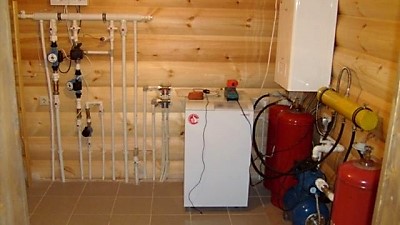
The gas autonomous heating system has a number of advantages:
- Independence from hot water supplied to the home;
- Economy due to low fuel consumption;
- Absolute autonomy of the system (it can be used regardless of the beginning/end of the heating season);
- Ease of use of all components of the device;
- Compactness and quiet operation of the heating device elements.
Important! Installation of such equipment in an apartment is possible only on condition that it fully meets certain requirements: ceiling height, dimensions of the entrance door, area of the premises, access to light, etc.
Warm floor in an apartment or one-story residential building
This method of heating a home cannot be considered the main one, but it is very relevant during major repairs. There are three types of heated floors: electric, water, infrared. Each of them has its own functional features.
So, the basis of the work of electrical — using a heating element embedded in a concrete screed or heating through a concrete layer. As a result, heat is either accumulated and given off, or given off as the element heats up, and a built-in thermostat allows you to regulate the heat level.
Water heated floor is represented by a set of metal-plastic water pipes laid under the floor covering. Infrared floor heating It works thanks to infrared plates that evenly heat the floor surface.
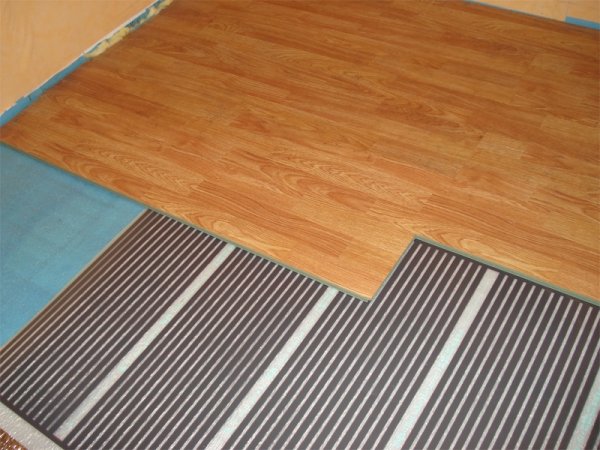
Photo 2. Installation of infrared heated floor. This type is perfect for use in apartments.
Each type of heated floor has its own pros and cons. Electric floors have the following advantages:
- Highly efficient;
- Convenient to use.
But they also have disadvantages:
- They are characterized by high energy consumption;
- May deform floors when overheated.
The advantages of water heated floors are that:
- 2 times more economical electric (fuel consumption is minimal);
- Very reliable:
- Long lasting.
Among the disadvantages they note: limited possibilities for application (such thermal structures are not suitable for apartments).
Infrared floors have shown their advantages in the short period of their existence:
- Low cost;
- Fast heating;
- Universality of application (suitable for any floor covering);
- Easy to install.
Heating system for bathroom
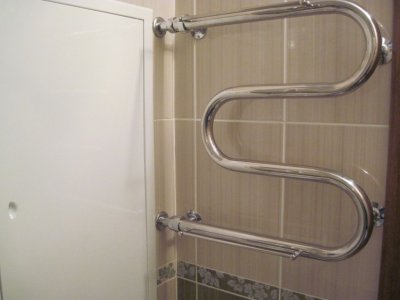
Since the bathroom is a fairly aggressive environment, this obliges apartment owners limit the list of heating devicesthat could be used in such a room.
Often, preference is given to one of the following options:
- Heated towel rails. Water and electric ones are used. The former are perfect for compact bathrooms, but they are unlikely to heat a large bathroom well. The latter look impressive, are expensive, and are used together with another type of heating (convector, heated floor, etc.).
- Convectors. Aesthetic, stylish, compact heating devices have gained popularity due to their practicality, durability, ease of use and ease of installation.
- Warm floor. Since the bathroom is a specific room, not every type of heated floor is suitable for it. The optimal option is considered to be the infrared option, in second place is electric floor heating.
Heating riser: purpose, actions when shutting off
This element of the heating system is a section of pipe that connects all the elements for stable and high-quality circulation of the coolant through the pipes. There are two types of heating risers:
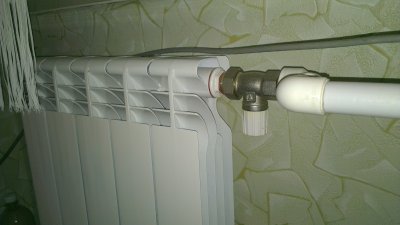
- Submitting — distribute the coolant into the radiators;
- Reverse — collect and drain cold water.
Sometimes consumers complain about an unpleasant situation: neighbors have shut off the heating riser. Many do not know how to behave in this situation.
To begin with, it is important to understand that risers are considered common property and the functionality of this heating element is the direct responsibility of the management company.
Therefore, when the above situation occurs a complaint/application is filed to the management company on your behalf (it would be nice if the list of signatories included more neighbors), and the created commission will visit the negligent tenant for further investigation.
Useful video
Watch the video, which tells how to make a heating system in an apartment with your own hands using a gas boiler.
Which option is better?
Each of the presented types of heating for an apartment has both obvious advantages and certain disadvantages. Choosing a suitable heating option for your own home should be based on several factors: first of all, financial capabilities, design features of the apartment, its area, etc. Good luck!










